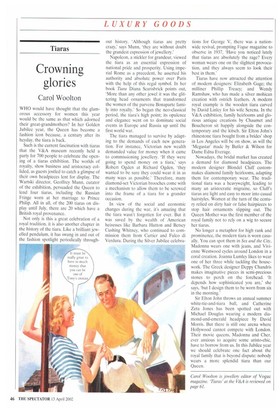Crowning glories
Carol Woolton
WHO would have thought that the glamorous accessory for women this year would be the same as that which adorned their great-grandmothers? In her Golden Jubilee year, the Queen has become a fashion icon because, a century after its heyday, the tiara is back.
Such is the current fascination with tiaras that the V&A museum recently held a party for 700 people to celebrate the opening of a tiaras exhibition. The worlds of royalty, show business and aristocracy collided, as guests jostled to catch a glimpse of their own headpieces lent for display. The Wartski director, Geoffrey Munn, curator of the exhibition, persuaded the Queen to lend four tiaras, including the Russian Fringe worn at her marriage to Prince Philip. All in all, of the 200 tiaras on display until July, there are 20 which have a British royal provenance.
Not only is this a great celebration of a royal tradition, it is also another chapter in the history of the tiara. Like a brilliant jewelled pendulum, it has swung in and out of the fashion spotlight periodically through out history. 'Although tiaras are pretty crazy,' says Munn, 'they are without doubt the grandest expression of jewellery.'
Napoleon, a stickler for grandeur, viewed the tiara as an essential expression of national pride and prosperity. Using imperial Rome as a precedent, he asserted his authority and absolute power over Paris with the help of this regal symbol. In her book Tiara Diana Scarisbrick points out, 'More than any other jewel it was the glittering head ornaments that transformed the women of the parvenu Bonaparte family into royalty.' So began the neo-classical period, the tiara's high point; its opulence and elegance went on to dominate social events in Europe and Russia up until the first world war.
The tiara managed to survive by adapting to the demands of each new generation. For instance, Victorian new wealth demanded value for money when it came to commissioning jewellery. 'If they were going to spend money on a tiara,' says Robert Ogden at Richard Ogden, 'they wanted to be sure they could wear it in as many ways as possible.' Therefore, many diamond-set Victorian brooches come with a mechanism to allow them to be screwed into the frame of a tiara for a grander occasion.
In view of the social and economic changes during the war, it's amazing that the tiara wasn't forgotten for ever. But it was saved by the wealth of American heiresses like Barbara Hutton and Betsey Cushing Whitney. who continued to commission them from Cartier and Fulco di Verdura. During the Silver Jubilee celebra tions for George V, there was a nationwide revival, prompting Vogue magazine to observe in 1937, 'Have you noticed lately that tiaras are absolutely the rage? Every woman wears one on the slightest provocation, and they always seem to look their best in them.'
Tiaras have now attracted the attention of modern designers: Elizabeth Gage; the milliner Phillip Treacy; and Wendy Ramshaw, who has made a silver mohican creation with ostrich feathers. A modern royal example is the wooden tiara carved by David Linley for his wife Serena. In the V&A exhibition, family heirlooms and glorious antique creations by Chaumet and Boucheron sit happily alongside the contemporary and the kitsch. Sir Elton John's rhinestone tiara bought from a brides' shop in Los Angeles will be on show, as will the `Megastar' made by Butler & Wilson for Dame Edna Everage.
Nowadays, the bridal market has created a demand for diamond headpieces. The modern designer Blondel Cluff custommakes diamond family heirlooms, adapting them for contemporary wear. The traditional tiara was a heavyweight, leading to many an aristocratic migraine, so Cluffs tiaras are light and easy to moor into casual hairstyles. Women at the turn of the century relied on dirty hair or false hairpieces to stop hair ornaments slipping out. The Queen Mother was the first member of the royal family not to rely on a wig to secure her tiaras.
No longer a metaphor for high rank and prominence, the modern tiara is worn casually. You can spot them in Sex and the Cirj. Madonna wears one with jeans, and Vivienne Westwood cycles around London in a coral creation. Joanna Lumley likes to wear one of her three while tackling the housework. The Greek designer Deppy Chandris makes imaginative pieces in semi-precious stones to perch on the forehead. 'It depends how sophisticated you are,' she says, 'but I design them to be worn from six in the morning.'
Sir Elton John throws an annual summer white-tie-and-tiara ball, and Catherine Zeta Jones has been spotted out with Michael Douglas wearing a modern diamond-and-emerald headpiece by David Morris. But there is still one arena where Hollywood cannot compete with London. Their movie queens, Madonna and Cher, ever anxious to acquire some aristo-chic, have to borrow from us. In this Jubilee year we should celebrate one fact about the royal family that is beyond dispute: nobody wears a more splendid tiara than our Queen.
Carol Woolton is jewellery editor of Vogue magazine. 'Tiaras' at the V&A is reviewed on page 61.


















































































 Previous page
Previous page